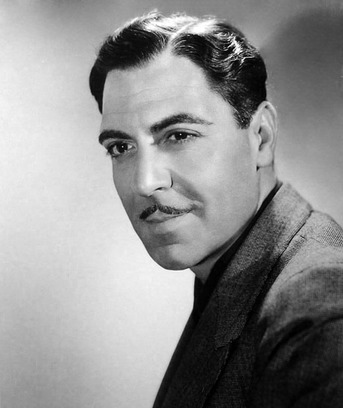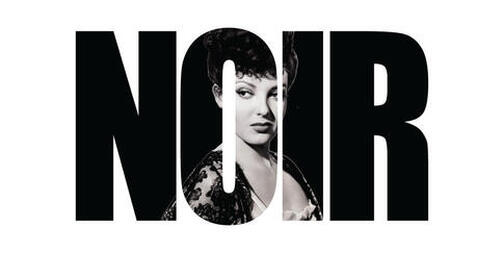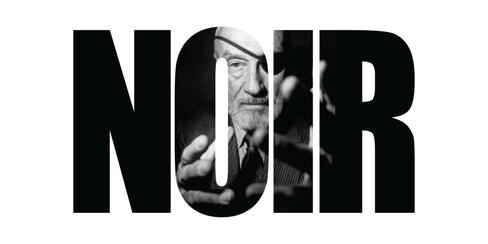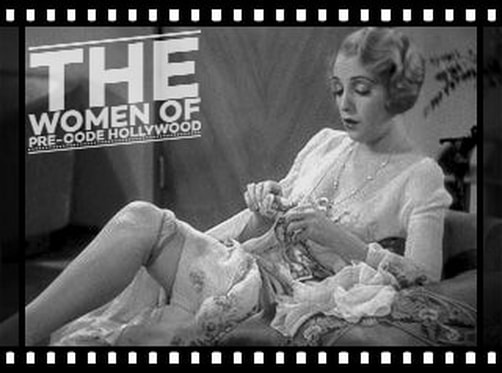JOSEPH CALLEIA
AND FILM NOIR
Joseph Calleia, born on August 4, 1897, in Malta, made a notable impact in the film noir genre through his memorable performances and distinctive presence. While not as widely recognized as some of his contemporaries, Calleia's contributions to film noir are significant, particularly in portraying menacing and morally ambiguous characters.
Calleia's most renowned role in film noir came in the 1942 classic "The Glass Key," directed by Stuart Heisler. He played the role of Nick Varna, a powerful and ruthless mobster. Calleia's portrayal of Varna was intense and menacing, capturing the essence of a classic noir villain. His performance added a sense of danger and intrigue to the film, elevating the tension and highlighting his ability to embody morally ambiguous characters.
Another notable film noir appearance by Calleia was in Orson Welles' "Touch of Evil" (1958). In this iconic noir film, Calleia played Pete Menzies, a seasoned police detective caught in a web of corruption and intrigue. Although his screen time was limited, Calleia's presence added depth and authenticity to the portrayal of the corrupt world in which the story unfolds.
Calleia's physical presence and distinctive voice contributed to his impact in the film noir genre. His deep, gravelly voice and commanding demeanor made him well-suited for playing characters with an air of authority and danger. Calleia's performances often brought an intensity and unpredictability to his roles, making his characters memorable and captivating on screen.
Beyond his specific film noir roles, Calleia appeared in a number of crime dramas and thrillers that contained noir elements. These Films showcased his ability to portray morally complex characters, adding depth to the narratives and contributing to the overall noir atmosphere.
While Joseph Calleia may not have achieved the same level of fame as some of his contemporaries in the film noir genre, his contributions were significant. His performances as menacing mobsters and morally ambiguous figures added depth and intensity to the films he appeared in. Calleia's distinct presence and ability to capture the essence of noir characters made him an impactful figure in the genre, leaving a lasting impression on audiences and contributing to the overall legacy of film noir.
Calleia's most renowned role in film noir came in the 1942 classic "The Glass Key," directed by Stuart Heisler. He played the role of Nick Varna, a powerful and ruthless mobster. Calleia's portrayal of Varna was intense and menacing, capturing the essence of a classic noir villain. His performance added a sense of danger and intrigue to the film, elevating the tension and highlighting his ability to embody morally ambiguous characters.
Another notable film noir appearance by Calleia was in Orson Welles' "Touch of Evil" (1958). In this iconic noir film, Calleia played Pete Menzies, a seasoned police detective caught in a web of corruption and intrigue. Although his screen time was limited, Calleia's presence added depth and authenticity to the portrayal of the corrupt world in which the story unfolds.
Calleia's physical presence and distinctive voice contributed to his impact in the film noir genre. His deep, gravelly voice and commanding demeanor made him well-suited for playing characters with an air of authority and danger. Calleia's performances often brought an intensity and unpredictability to his roles, making his characters memorable and captivating on screen.
Beyond his specific film noir roles, Calleia appeared in a number of crime dramas and thrillers that contained noir elements. These Films showcased his ability to portray morally complex characters, adding depth to the narratives and contributing to the overall noir atmosphere.
While Joseph Calleia may not have achieved the same level of fame as some of his contemporaries in the film noir genre, his contributions were significant. His performances as menacing mobsters and morally ambiguous figures added depth and intensity to the films he appeared in. Calleia's distinct presence and ability to capture the essence of noir characters made him an impactful figure in the genre, leaving a lasting impression on audiences and contributing to the overall legacy of film noir.
AVAILABLE FILMS:
AFTER THE THIN MAN (1936)
ALAMO, THE (1960)
ALGIERS (1938)
BEGINNING OR THE END, THE (1947)
CAPTAIN CAREY, U.S.A (1950)
CONSPIRATORS, THE (1944)
CROSS OF LORRAINE, THE (1943)
DEADLINE AT DAWN (1946)
FIVE CAME BACK (1939)
FULL CONFESSION (1939)
GILDA (1946)
GLASS KEY, THE (1942)
GOLDENBOY (1939)
HIS BROTHER'S WIFE (1936)
JOHNNY COOL (1963)
JUAREZ (1939)
MY LITTLE CHICKADEE (1940)
LURED (1947)
PUBLIC HERO NO. 1 (1935)
RIFF RAFF (1935)
SINNER TAKE ALL (1936)
SWORN ENEMY (1936)
TOUCH OF EVIL (1958)
ALAMO, THE (1960)
ALGIERS (1938)
BEGINNING OR THE END, THE (1947)
CAPTAIN CAREY, U.S.A (1950)
CONSPIRATORS, THE (1944)
CROSS OF LORRAINE, THE (1943)
DEADLINE AT DAWN (1946)
FIVE CAME BACK (1939)
FULL CONFESSION (1939)
GILDA (1946)
GLASS KEY, THE (1942)
GOLDENBOY (1939)
HIS BROTHER'S WIFE (1936)
JOHNNY COOL (1963)
JUAREZ (1939)
MY LITTLE CHICKADEE (1940)
LURED (1947)
PUBLIC HERO NO. 1 (1935)
RIFF RAFF (1935)
SINNER TAKE ALL (1936)
SWORN ENEMY (1936)
TOUCH OF EVIL (1958)
VIDEO TRIBUTE
Joseph Calleia

Joseph Calleia was a Maltese-American actor, born on August 4, 1897, in Sliema, Malta. He had a successful career in both film and theater, known for his distinctive voice, powerful presence, and memorable performances.
Calleia began his acting career in London's West End theater before making his way to the United States in the 1920s. He initially found success on Broadway, appearing in several notable productions. In 1929, he made his film debut in the crime drama "The Racket," which was a critical and commercial success.
Throughout the 1930s and 1940s, Calleia became known for his performances in various genres, often portraying tough and menacing characters. He appeared in several crime films, including "Algiers" (1938) and "The Glass Key" (1942). One of his most memorable roles came in the film noir classic "Gilda" (1946), where he played the enigmatic casino owner Ballin Mundson opposite Rita Hayworth.
Calleia was praised for his ability to bring depth and complexity to his characters. His commanding presence and intense performances made him a sought-after character actor. He worked with renowned directors such as Orson Welles, appearing in Welles' films "The Magnificent Ambersons" (1942) and "Touch of Evil" (1958).
In addition to his film work, Calleia continued to appear on stage, including a notable performance as Willie Loman in the original Broadway production of Arthur Miller's "Death of a Salesman" in 1949.
Calleia's career spanned several decades, and he appeared in over 70 films. He also had a strong presence on television, making guest appearances in popular shows of the time.
Joseph Calleia retired from acting in the early 1960s and lived a relatively private life until his death on October 31, 1975, in Sliema, Malta.
His contributions to the world of film and theater, particularly in the crime and film noir genres, are remembered and appreciated. Joseph Calleia's performances continue to captivate audiences, and he is recognized as a talented and versatile actor.
Calleia began his acting career in London's West End theater before making his way to the United States in the 1920s. He initially found success on Broadway, appearing in several notable productions. In 1929, he made his film debut in the crime drama "The Racket," which was a critical and commercial success.
Throughout the 1930s and 1940s, Calleia became known for his performances in various genres, often portraying tough and menacing characters. He appeared in several crime films, including "Algiers" (1938) and "The Glass Key" (1942). One of his most memorable roles came in the film noir classic "Gilda" (1946), where he played the enigmatic casino owner Ballin Mundson opposite Rita Hayworth.
Calleia was praised for his ability to bring depth and complexity to his characters. His commanding presence and intense performances made him a sought-after character actor. He worked with renowned directors such as Orson Welles, appearing in Welles' films "The Magnificent Ambersons" (1942) and "Touch of Evil" (1958).
In addition to his film work, Calleia continued to appear on stage, including a notable performance as Willie Loman in the original Broadway production of Arthur Miller's "Death of a Salesman" in 1949.
Calleia's career spanned several decades, and he appeared in over 70 films. He also had a strong presence on television, making guest appearances in popular shows of the time.
Joseph Calleia retired from acting in the early 1960s and lived a relatively private life until his death on October 31, 1975, in Sliema, Malta.
His contributions to the world of film and theater, particularly in the crime and film noir genres, are remembered and appreciated. Joseph Calleia's performances continue to captivate audiences, and he is recognized as a talented and versatile actor.
Quotes:
None Available
Trivia:
During his retirement time in Malta he received a telegram from Francis Ford Coppola, who offered him the part of Don Vito Corleone in The Godfather (1972). As much as Coppola wanted Calleia for the part, Calleia had to refuse because of health reasons.
Orson Welles was extremely impressed by a stage performance of Calleia's in the mid-1930s and vowed to work with him. They finally worked together over 20 years later in Touch of Evil (1958).
Before becoming an actor he was a professional opera singer.
Orson Welles was extremely impressed by a stage performance of Calleia's in the mid-1930s and vowed to work with him. They finally worked together over 20 years later in Touch of Evil (1958).
Before becoming an actor he was a professional opera singer.




